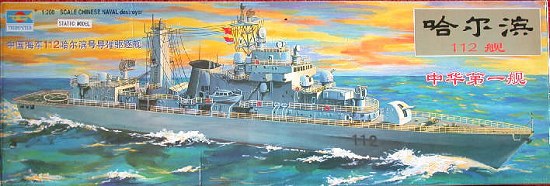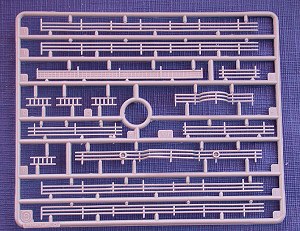
|
KIT: |
Trumpeter 1/200 Harbin-Luhu class Destroyer |
|
KIT # |
03603 |
|
PRICE: |
€32.00 |
|
DECALS: |
yes |
|
REVIEWER: |
|
|
NOTES: |
designed for radio control. |

|
HISTORY |
Let me first tell you that this is my first kit of abovenamed chinese company. I´ve kept track of Trumpeter´s appearance on the market and of the reaction its kits provoked. Here´s a chinese company that hurls in rapid succession a vast number of fresh and ambitious kits in unusual (mostly rather big) scales at the international modeling crowd. Many of them are rather pricey, and they are meeting a mixed reception from the internet modeling crowd. Whilst the tanks seem to be met rather positive, many of the planes are subject to the wildest discussions – I just say Wildcat. On the whole, I´ve read anything from „kiss it“ to „diss it“ and was rather curious what this particular offering – copyrighted in 2000 - would be like. Being ever more interested in ships and looking for a practice build, I picked this one up on ebay at a rather acceptable price. In fact, my mind is already set on Trumpeter´s russian Sovremenny destroyer, of which I´ve read some rather favourable reviews, but it´s about three times the price of this offering ...
The original is a good example of China´s efforts in producing warships to current international standard with all its successes and failures. The use of foreign technology from various sources and the changes in international relations before and after the Tiananmen massacre of 1989 are also refelcted in this ship´s design. It is a transitional type that did not meet all the requirements and hence only two of them were built. The following text is from the federation of American Scientists website www.fas.org :
Luhu-class Multirole Destroyer
The Luhu-class missile destroyers are the most sophisticated Chinese-built surface combatants in the PLA Navy, but are still obsolete by Western standards. The first truely multi-role Chinese ships, they were designed by the China Warship Design Institute (formerly known as the Seventh Academy of the Ministry of National Defense). They were built at the Jiangnan Shipyard, which had previously built ten other types of warships, including its first gunboat, first submarine, first frigate, and first marine survey ship. The Luhu-class are armed with C-802 ship-to ship missiles, along with "Sea Rattlesnake" air defense missiles and one helicopter.
Compared to the old Luda class DDG, this class represents a significant step forward in terms of weapon and electronic systems. The Luhu destroyer is the first Chinese naval system of indigenous design even approaching modern standards. But the decision to buy Sovremenny-class destroyers from Russia to accomplish the same functions is indicative of the problems confronting Chinese weapons designers. The Luhu-class air-defence systems lack a fleet defence capability beyond visual range.
The first of the new class was ordered in 1985, but delayed by priority being given to export orders for Thailand. Although these ships were intended to accomodate the American LM2500 gas turbine engines, the Chinese naval architects responsible for designing the Luhu's hull and engine space seem to have disregarded the engines' size specifications. The hull had to be returned to the shipyard for redesign after at least one ship had already been built.
These ships make use of over 40 advanced foreign technologies, providing the Chinese military with an opportunity to cooperate with foreign manufacturers on an extensive scale. Since most of the equipment on board is imported, the crew has to study English to learn over 1,000 English words so they can operate the imported equipment. Among the western equipments on the LuHu class is the Thomson-CSF TAVITAC combat data system, the Thomson- CSF TSR 3004 Sea Tiger Air/Surface search radars, and French-made guns, obtained before the Tiananmen incident (in 1989) when Western countries were still helping China with its military modernization programs. While the first two units are equipped with two US-made GE LM2500 gas turbine engines, the third Type 052 warship and follow-up vessels will use the Ukrainian GT25000M gas turbine as their main engine.
Historically the biggest weakness of Chinese destroyers and frigates has been their inadequate of ship-to-air missiles. Because they have small displacements, most of the destroyers and frigates are not equipped with short-range and intermediate-range missiles, but use artillery with a limited firing range, one-man air defense missiles, and a small number of PL-8H short-range ship-to-air missiles for air defense. The weakness in air defense capabilities has confined the activity of China's destroyers and frigates to the Chinese coastal waters, within the area covered by the fighters of the Chinese Navy. The new Luhu class destroyers and Jiangwei class frigates are equipped with relatively advanced ship-to-air missiles, such as HQ-61B's with a firing range of 10 km and Sea Sidewinders with a firing range of 14 km, giving the Chinese Navy full capabilities of air defense in distant seas.
The weakness of this type destroyer is its poor electronic surveillance system, which renders it vulnerable to being located and attacked. Reportedly China has introduced improved electronics systems, including technology acquired from the US and France, leading to the introduction of an improved and enlarged version of the Luhu as the Luhai-class of guided missile destroyers, which are apparently intended to have enhanced air defense capabilities. The introduction of Luhai-class suggests that the 052 Luhu building project may have been terminated.
The Harbin is the first Luhu-class 052 missile- destroyer of the Chinese Navy. The Harbin (DD 112) and two other Chinese ships visited San Diego CA on 21 March 1997 in the first-ever visit by People's Republic of China Navy ships to the mainland US. The ships visited Hawaii on their way to Southern California for the second part of a goodwill visit between the US and Chinese navies. http://www.fas.org/man/dod-101/sys/ship/row/plan/luhu.htm
Info on the improved Luhai-Class will be found at: http://www.fas.org/man/dod-101/sys/ship/row/plan/luhai.htm
The shipboard helicopter is described at: http://www.fas.org/man/dod-101/sys/ac/row/dauphin.htm
|
THE KIT |
So what do you get for your money?
First of all, I now know what Scott means with „a sturdy cardboard box“, as my kit is packed in exactly one. The boy itself has two compartments, one for the one-piece hull which is secured by a cardboard holder. The box is graced by a sticker saying „Static Model“. More on this later.
 Inside is the one-piece hull, seven
sprues of light gray plastic (three of them ladders and railings), plus
one silver gray sprue for the stand, a clear spure, a black sprue with
two sets off handed propellers, two propeller shafts and a plastic bag
with fittings for the rudder assembly.
Inside is the one-piece hull, seven
sprues of light gray plastic (three of them ladders and railings), plus
one silver gray sprue for the stand, a clear spure, a black sprue with
two sets off handed propellers, two propeller shafts and a plastic bag
with fittings for the rudder assembly.
The kit is designed for radio control. Hence, mountings for antenna, batteries, receiver, engine, rudder servo and so on are integral to the hull, and the rear part of the superstructure is to be built removable to access the inside. The model is at this scale fairly large with a length of 713.5 mm and a beam of 75 mm. Yet you have only about 20 mm from the waterline to the deck, and even less space at the stern where there´s a large open area under the helipad for some towed sonar device. Hence, Trumpeter chose to put clear parts into these openings. All other windows and bulleyes have to be painted on or replaced by PE.
The instructions are
Chinese-American with reference to Tamiya colors, if I´m right. They also
describe how to mount the R/C equipment, which is not included in this
static version. I anyway do not intend to let my Harbin swim ...
The kit is definitely not cutting-edge as regards to level of detail. Generally, all shapes are softened, simplified and rounded, which is especially notable with the helicopter (which should be a licence-built french Dauphin type) and the motor launch. Given the approach of building a workable model, this is not wrong at all, as stability and rugged construction are paramount, but it gives the static builder some more work to do. As far as I understood, Trumpeter has progressed towards more detail with the Sovremenny kit which is primarily a static model.
 The consequence is that all the
railings are oversized, as well as the masts and radars. It is surely
possible to make this kit into a fine representation of the original, but
surely not without aftermarket parts. I do not mean to say that the fit
is bad; at least the major components fit fine when I held them together,
and I do not assume the fit of the other parts will be worse. Yet they
are simplified throughout.
The consequence is that all the
railings are oversized, as well as the masts and radars. It is surely
possible to make this kit into a fine representation of the original, but
surely not without aftermarket parts. I do not mean to say that the fit
is bad; at least the major components fit fine when I held them together,
and I do not assume the fit of the other parts will be worse. Yet they
are simplified throughout.

Technically speaking, there are nasty seams on the underwater hull around the propeller outlets and the stabilizers – I guess they´re caused by mold necessities – and I suppose they can be easily cleaned up. But I did not find flash or other major ugly spots caused by the engineering and molding process.
|
CONCLUSIONS |
On the whole, with some individual
extra work this kit may surely be made to a fine model of a little known
vessel. But there is no
 special PE set for it, and you have to use
generic railings and other fittings and you won´t be able to avoid some
scratchbuilding in completing it. But as a test piece, I think it´s fine
and right on the money.
special PE set for it, and you have to use
generic railings and other fittings and you won´t be able to avoid some
scratchbuilding in completing it. But as a test piece, I think it´s fine
and right on the money.
I might of course yet begin my building review with the words „Don´t say you weren´t warned“ or „Well folks, this is the first kit I sank with firecrackers in a neighborhood pond since I was 13“, but – we anticipate ;-)))
If you would like your product reviewed fairly and quickly by a site that has over 200,000 visitors a month, please contact me or see other details in the Note to Contributors.